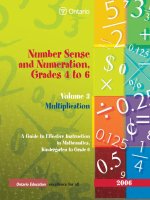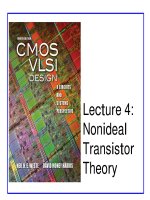LECTURE 4: CONDITIONAL PROBABILITY, APPLICATIONS, GEOMETRIC DISTRIBUTION pdf
Bạn đang xem bản rút gọn của tài liệu. Xem và tải ngay bản đầy đủ của tài liệu tại đây (259 KB, 24 trang )
Probability in Computing
© 2010, Quoc Le & Van Nguyen
Probability for Computing 1
LECTURE 4: CONDITIONAL PROBABILITY,
APPLICATIONS, GEOMETRIC DISTRIBUTION
Agenda
Application: Verification of Matrix
Multiplication
Application: Randomized Min
-
Cut
© 2010, Quoc Le & Van Nguyen
Probability for Computing 2
Application: Randomized Min
-
Cut
Geometric Distribution
Coupon Collector’s Problem
Application: Verifying Matrix
Multiplication
Consider matrix multiplication AB = C (integers
modulo 2)
Simple algorithm takes O(n
3
) operations.
Want to check if a given matrix multiplication program
works correctly
Randomized Algorithm:
© 2010, Quoc Le & Van Nguyen
Probability for Computing 3
Randomized Algorithm:
Choose a random vector r = (r
1
, r
2
, …, r
n
) in {0,1}
n
.
Compute A(Br) and Cr then comparer the two values: if equal
return yes AB=C, else no.
Note on the above randomized algorithm:
1-side error
Complexity = O(n
2
)
Accuracy depends on P(ABr = Cr) when AB!=C
Analysis of P(ABr = Cr)
Choosing r randomly is equivalent to choosing r
i
randomly and
independently. (1)
Let D = AB – C ≠ 0. Since Dr = 0, there must be some non-zero
entry. Let that be d
11
.
Dr = 0 ∑d
1j
r
j
= 0 r
1
= -∑d
1j
r
j
/ d
11
.
Since r1 can take 2 values, combine with (1), we have ABr = Cr with
© 2010, Quoc Le & Van Nguyen
Probability for Computing 4
Since r1 can take 2 values, combine with (1), we have ABr = Cr with
probability of at most ½
Refer to book for formal proof (using Law of Total Probability)
Principle of Deferred Decisions: when there are several random
variables, it often helps to think of some of them as being set at
one point in the algorithm with the rest of them being left
random (or deferred) until some further point in the analysis.
We can attempt this verification k times to obtain accurate
answer with p = 2
-k
and efficiency = O(kn
2
) = O(n
2
)
Theorems
Law of Total Probability: Assume E
1
, E
2
, …, E
n
be
mutually disjoint events in the sample space
Ω and
union of E
i
= Ω. Then
Pr(B) = ∑Pr(B and E
i
) = ∑Pr(B|E
i
)Pr(E
i
)
Bayes’ Law: Assume E
, E
, …, E
be mutually disjoint
© 2010, Quoc Le & Van Nguyen
Probability for Computing 5
Bayes’ Law: Assume E
1
, E
2
, …, E
n
be mutually disjoint
events in the sample space Ω and union of E
i
= Ω.
Then
Pr(E
j
|B) = Pr(E
j
and B)/Pr(B)
= Pr(B|E
j
)Pr(E
j
) / ∑Pr(B|E
i
)Pr(E
i
)
Notice the model transformation from prior probability to
posterior probability.
Gradual Change in Our Confidence in
Algorithm Correctness
In matrix verification case:
E = the identify is correct
B = test returns that the identity is correct
Prior assumption: Identity = ½
How does this assumption change after each run?
© 2010, Quoc Le & Van Nguyen
Probability for Computing 6
How does this assumption change after each run?
We start with Pr(E) = Pr(E
c
) = ½
Since the test has error bounded by ½, Pr(B|E
c
) ≤
½. Also, Pr(B|E) = 1
Now by Bayes’ Law:
Pr(E|B) =
Pr(B|E)Pr(E) / {Pr(B|E)Pr(E)+ Pr(B|E
c
)Pr(E
c
)}≥
½ / {1.½ + ½. ½} = 2/3
The prior model is revised:
Pr(E) ≥ 2/3 and Pr(E
c
) ≤ 1/3.
Applying Bayes’ Law again will yeild Pr(E|B) ≥
4/5
Gradual Change in Our Confidence in
Algorithm Correctness
© 2010, Quoc Le & Van Nguyen
Probability for Computing 7
4/5
In general, at i
th
iteration, Pr(E|B) ≥1 –
1/(2
i
+1)
After 100 calls, test returns that identity is
correct, then our confidence in the
correctness of this identity is at least 1 – 1/
2
100
+1)
Application: Randomized Min
Cut
Cut-set: Set of edges whose removal breaks
the graph into two or more connected
components.
© 2010, Quoc Le & Van Nguyen
Probability for Computing 8
Min-cut: Cut-set with minimum cardinality.
Applications:
Network reliability.
Clustering problems
Al-Qaeda
Example
A
B
G
E
F
© 2010, Quoc Le & Van Nguyen
Probability for Computing 9
C
B
D
G
E
Example
A
B
G
E
F
© 2010, Quoc Le & Van Nguyen
Probability for Computing 10
C
B
D
G
E
E1 = BE
Karger algorithm
Edge contraction (collapsing an edge): To
collapse edge {u,v}, we
Create a new node uv
Replace any edge of form u, w or v, w with new edge uv,
w
© 2010, Quoc Le & Van Nguyen
Probability for Computing 11
Delete original vertices u and v.
Resulting graph is denoted G/{u,v}.
Repeat until 2 nodes left (n-2 iterations):
Choose edge at random
“Contract” edge.
Take all the edges between them as min-cut
Example
A
C
B
G
E
F
© 2010, Quoc Le & Van Nguyen
Probability for Computing 12
C
D
Example
A
C
B
G
E
F
contract
© 2010, Quoc Le & Van Nguyen
Probability for Computing 13
C
D
Example
A
C
B
D
G
E
F
contract
© 2010, Quoc Le & Van Nguyen
Probability for Computing 14
D
A
C
B
D
E
FG
Example
A
C
B
D
G
E
F
contract
© 2010, Quoc Le & Van Nguyen
Probability for Computing 15
D
A
C
B
D
E
FG
contract
Example
A
C
B
D
G
E
F
contract
© 2010, Quoc Le & Van Nguyen
Probability for Computing 16
D
A
C
B
D
E
FG
contract
A
C
B E
FGD
Analysis
Let k be the size of the min-cut set of G
We want to compute the probability of finding one such
set C.
C partition V (set of vertices) in to S and V-S
If the algorithm never choose an edge in C in its n
-
2
© 2010, Quoc Le & Van Nguyen
Probability for Computing 17
If the algorithm never choose an edge in C in its n
-
2
iterations, then the algorithm will return C as minimum
cut-set.
Let E
i
= edge contracted in iteration i is not in C
Let F
i
= Union of E
j
(j = 1i) = no edge of C was
contracted in the first i iterations.
We need to compute Pr(F
n-2
)
Analysis
All vertices have degree k or larger graph must have ≥ nk/2
edges.
Pr(F
1
) = Pr(E
1
) ≥ 1 – k/ (nk/2) = 1 – 2/n
Conditionally:
Pr(E
2
|F
1
) ≥ 1 – k/ (k(n-1)/2) = 1 – 2/(n-1).
Similarly: Pr(E
|F
) ≥ 1
–
2/(n
-
i+1)
© 2010, Quoc Le & Van Nguyen
Probability for Computing 18
Similarly: Pr(E
i
|F
i-1
) ≥ 1
–
2/(n
-
i+1)
Therefore:
Pr(F
n-2
) = Pr(E
n-2
|F
n-3
)* Pr(F
n-3
)+ Pr(E
n-2
|F
n-3
c
)* Pr(F
n-3
c
)
= Pr(E
n-2
|F
n-3
)* Pr(F
n-3
) since Pr(E
n-2
|F
n-3
c
)=0
So,
Pr(F
n-2
) = Pr(E
n-2
|F
n-3
)* Pr(F
n-3
) = Pr(E
n-2
|F
n-3
)* Pr(E
n-3
|F
n-4
) * Pr(F
n-
4
) =
Pr(E
n-2
|F
n-3
)* Pr(E
n-3
|F
n-4
) *… * Pr(E
2
|F
1
) * Pr(F
1
) = 2/n(n-1).
What’s next
Karger: Use of idea of amplification – Run algorithm many
times and return the smallest guess.
Our probability of success ≥ 1 – ( 1 – 2/n(n-1) )
N
≥ 1 – e
-
2N/n(n-1)
. (due to 1-x ≤e
-x
)
© 2010, Quoc Le & Van Nguyen
Probability for Computing 19
Choose N = c(n choose 2) ln(n), for some constant c, then it
is correct with probability at least 1 – 1/n
c
.
Complexity = O(n
4
logn).
We can reduce the time complexity by an order of n2 to
obtain O(n
2
(logn)
3
) -
/>Winter05/Handouts/05-mincut.pdf
Geometric Distribution
Flip a coin until it lands on head. What is the
distribution of the number of flips?
Perform a sequence of independent trials until
the first success, where each trial succeeds
© 2010, Quoc Le & Van Nguyen
Probability for Computing 20
the first success, where each trial succeeds
with prob. = p.
Def: A geometric random variable X with
parameter p is given by the following
probability distribution:
Pr(X=n)=(1-p)
n-1
.p
Properties
Lemma 1: (Memory-less): Pr(X=n+k|X>k) =
Pr(X=n)
Lemma 2: Let X be a discrete random variable
© 2010, Quoc Le & Van Nguyen
Probability for Computing 21
Lemma 2: Let X be a discrete random variable
that takes on only non-negative integer values.
Then: E[X] = ∑Pr(X≥i) (i = 1 ∞)
For a geometric random variable X(p), Pr(X ≥i) = (1-p)
i-1
E[X] = 1/p.
Coupon Collector Problem
Problem: Suppose that each box of cereal contains
one of n different coupons. Once you obtain one of
every type of coupon, you can send in for a prize.
Question: How many boxes of cereal must you buy
before obtaining at least one of every type of coupon.
© 2010, Quoc Le & Van Nguyen
Probability for Computing 22
before obtaining at least one of every type of coupon.
Let X be the number of boxes bought until at least
one of every type of coupon is obtained.
Let X
i
be number of boxes bought while you had
exactly i-1 different coupons.
Then: X = ∑X
i
.
Coupon Collector’s Problem
Probability of obtaining a new coupon when i -1
coupons have been found: p
i
= 1 – (i-1)/n.
Hence, E[X
] = 1/p
= n/(n
-
i+1)
© 2010, Quoc Le & Van Nguyen
Probability for Computing 23
Hence, E[X
i
] = 1/p
i
= n/(n
-
i+1)
E[X] = ∑E[X
i
] = n ∑1/i = nH(n) (harmonic number) =
nln(n).
Application: Packet Sampling
Sampling packets on a router with probability p
The number of packets transmitted after the last sampled
packet until and including the next sampled packet is
geometrically distributed.
From the point of destination host, determining all
© 2010, Quoc Le & Van Nguyen
Probability for Computing 24
From the point of destination host, determining all
the routers on the path is like a coupon collector’s
problem.
If there’s n routers, then the expected number of
packets arrived before destination host knows all of
the routers on the path = nln(n).









